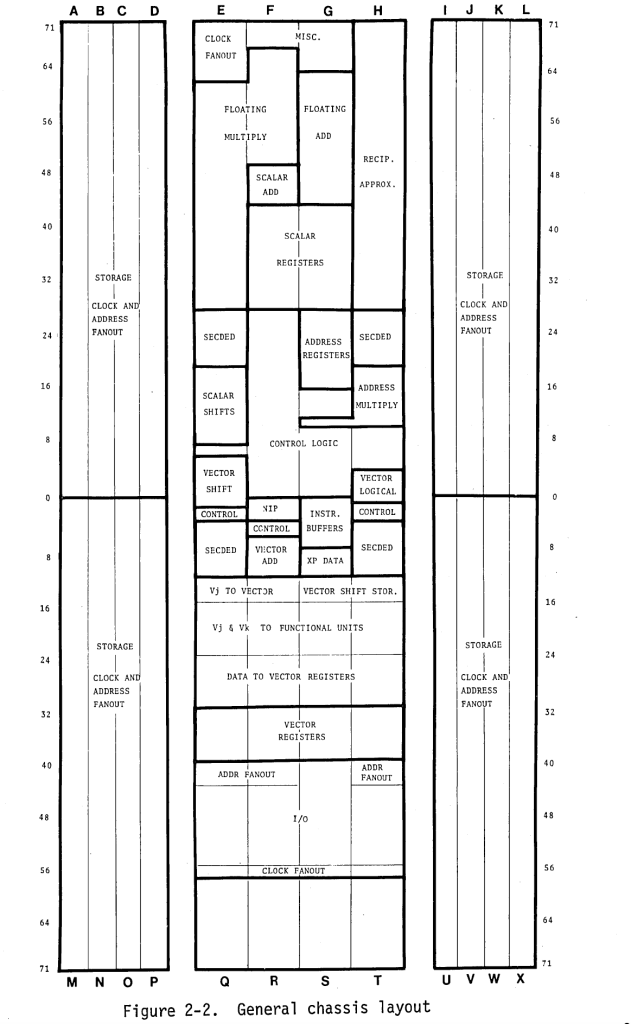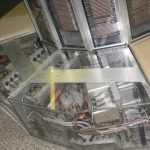Cray-1 Machines
The Cray-1 is the foundation from which the supercomputing industry was born. This was not the first computer aimed at the technical market but a combination of innovation, speed and reliability propelled the Cray-1 into computing legend. The Cray-1 series of computers were manufactured from 1976 till 1983. About 60 of these machines were delivered to customer locations all over the world. At the time, they were the undisputed highest performing computers for scientific workloads. The Cray-1 system had the peripherals attached to the mainframe. The Cray-1S introduced the Input-Output Subsystem to handle the external processing of data. The reliability and performance of Cray-1 systems established the Cray Research brand as a market leader in the new field of supercomputing.

List of customers and locations of Cray-1 and Cray-2 systems
Cray-1 Supercomputer 30th Anniversary by CHM Youtube video.
Timing Codes On Cray-1:Principles and applications from LLNL
US4128880 – Computer vector register processing – Original Patient
Sales and technical descriptions:
See more glorious pictures of Cray-1 systems here.
Cray-1 description paper by Russell
This paper describes the CRAY – 1, discusses the evolution of its architecture, and gives an account of some of the problems that were overcome during its manufacture. The CRAY-1 is the only computer to have been built to date that satisfies ERDA’s Class VI requirement (a computer capable of processing from 20 to 60 million floating point operations per second). The CRAY-1’s Fortran compiler (eFT) is designed to give the scientific user immediate access to the benefits of the CRAY-l’s vector processing architecture. An optimizing compiler, eFT, “vectorizes” innermost DO loops. Compatible with the ANSI 1966 Fortran Standard and with many commonly supported Fortran extensions, eFT does not require any source program modifications or the use of additional nonstandard Fortran statements to achieve vectorization. Thus the user’s investment of hundreds of man months of effort to develop Fortran programs for other contemporary computers is protected.
Smithsonian installation at the National air and space museum

Smithsonian Institution’s National Air and Space Museum (NASM)
SPACE ARTIFACTS: CRAY-1 SUPERCOMPUTER
The CRAY-1 is an early example of a class of machines called “supercomputers,” so named because of their ability to solve very complex mathematical problems that ordinary computers-even large commercial systems-cannot practically handle. This machine, serial #14, was sold by Cray Research, Inc. of Chippewa Falls, Wisconsin, and installed at the National Center for Atmospheric Research (NCAR) in Boulder, Colorado. The CRAY-1‘s designer, and founder of the company, was Seymour R. Cray (1926-1996), who before founding Cray Research had previously had designed advanced computers for UNIVAC and the Control Data Corporation. Unlike most computers which consist of rectangular boxes filled with printed circuit boards, the CRAY-1 is wired with thousands of wires soldered by hand, and its circuits are arranged in a three-quarters circle. Both help increase the speeds at which signals travel from one part of the computer to another. Hefty power supplies, covered with naugahyde, are located below each of the circuit bays, giving the overall impression of a very expensive piece of lounge furniture.
AT NCAR, the machine was used between (approximately) 1977 and 1983, where it performed complex calculations involving the numerical modeling of weather phenomena. Other CRAY-1 computers installed elsewhere were used for modeling nuclear reactions inside weapons, code breaking, and the behavior of air over wings an other surfaces. It is, of course, this latter application that is of interest to the National Air and Space Museum and the reason this machine is in its collections. From a mathematical standpoint, however, the equations solved in three of the above four areas are similar, and involve the flows of fluids in complex, nonlinear ways. For the aerospace community the advent of supercomputers has been almost revolutionary. The complexities of fluid flow have always resisted a direct mathematical analysis. From the time of the Wright Brothers aircraft designers have relied on the wind tunnel to develop and refine their designs. Wind tunnels, however, are expensive to operate, and it is especially difficult to build tunnels that operate at the high speeds encountered by modern vehicles such as the Space Shuttle. Supercomputers can thus supplement tunnels in many areas, although earlier predictions that they would completely replace tunnels proved to be naive. A CRAY-1 cost on the order of $10 million, but when properly used it could easily pay for itself in terms of reduced wind tunnel time, and resulting vehicles that flew with better performance. Modern transport aircraft like the Boeing 777, and new-generation space vehicles like the Lockheed Martin Venture Star, would be inconceivable without supercomputers.
The CRAY-1‘s performance was measured in how many millions of instructions it could perform in a second. Its processing speeds, of around 150 million floating point operations per second, were far above anything else that the time of its announcement in 1976. Those speeds are now matched by inexpensive workstations that fit on a person’s desk. Cray Research, later bought by the workstation company Silicon Graphics, continues to design and deliver advanced supercomputers, and a handful of other companies also supply this market. With the end of the Cold War, the Defense Department’s needs for supercomputers diminished, and that led to financial losses for supercomputer companies. The commercial market remains healthy and growing, though it will probably always remain small.
See more glorious pictures of Cray-1 systems here.













































